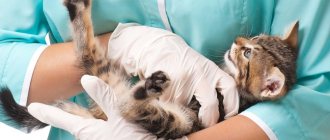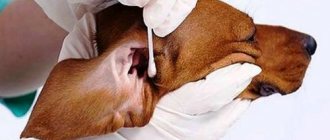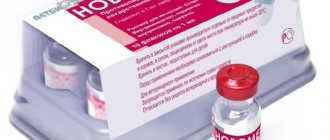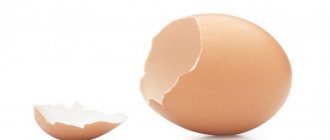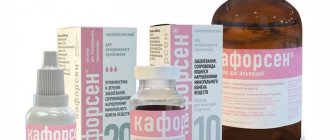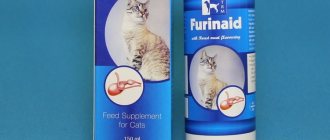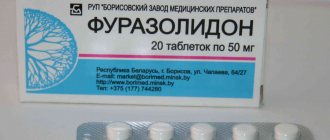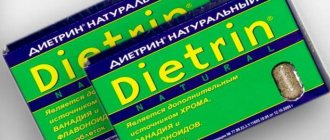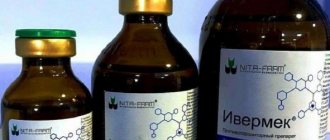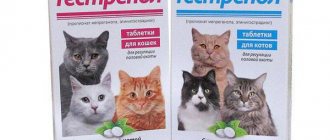general description
The antispasmodic is produced in several dosage forms:
- Injection. The transparent liquid is packaged in sealed glass ampoules. Some manufacturers use bottles with a plastic cap. They are considered more convenient to use, since there is no risk of injury from glass when opening. 1 ml of solution usually contains 20 mg of papaverine hydrochloride. The composition also includes purified water and other components.
- Pills. Round white tablets are packaged in contour cells of 10 pieces. In pharmacies they come in two dosages - one tablet may contain 10 or 40 mg of the active substance. In addition, the composition includes potato starch, talc, stearic acid and other components that perform exclusively an auxiliary function.
- Rectal suppositories. Small candles are packaged in PVC plates. The concentration of the active substance in them is 20 mg. Excipients are solid fat, emulsifier and cosmetic stearin.
For cats, Papaverine is most often used in injections. The solution is quick-acting, but the tablets are less effective. The active substance included in their composition “works” on the body only half (bioavailability is only 54%). Candles for animals are used in rare cases.
Pharmacological forms and dosages
The drug is available in three forms:
- In tablets, the weight of which is 0.25 and 0.5 grams, and they can be packaged both in plastic jars (there are 24 tablets) and in plates (10 pieces each),
- As a liquid for injection, it has a white or white-yellow color. It is administered intramuscularly.
- In powder form. It must be mixed with water or food.
In what doses should I give the drug in tablets to a cat?
Owners and some veterinarians do not like this form of release. Because it should be 12.5 mg per kg of animal weight. And calculating the dose is often difficult. In some cases, there is a different dosage if the veterinarian considered it necessary to indicate this.
If we talk about such a form of release as injections, then the drug is available in bottles of 100 and 10 ml. Which is very convenient if your pet does not have a severe form of his disease, and he is prescribed only 1 to 3 injections.
Before giving your cat an injection, be sure to shake the bottle
It is also important to make sure that both the needle and syringe are completely dry. It is advisable for the cat to give a light massage to the future site of drug administration.
The drug can be bought in tightly closed glass vials of different volumes; it can be said to vary diametrically, from 10 to 250 milliliters.
The active substance contained in one milliliter of this liquid also differs, although not so much, 150 or 200 mg.
Typically, veterinarians use injections (15 percent solution). Of course, veterinary pharmacies sell suspensions for injections, but some experts do not recommend using it, because in their opinion, tumors may appear at the injection site, and also, in their opinion, because the procedure is unnecessarily painful. The kitty’s body accepts the solution much better.
How it works
The medication has an antispasmodic effect, that is, the ability to eliminate spasms. The drug also relieves pain that accompanies spasms and lowers blood pressure. The effect of the drug is due to the fact that the active substance blocks the synthesis of enzymes, as a result of which the tone of the smooth muscles that make up the stomach, bladder, kidneys and other internal organs decreases.
When smooth muscle tone is greatly increased, a spasm occurs, which is usually accompanied by acute pain. Under the influence of Papaverine, the muscles of the internal organs relax and tone decreases. The medicine also helps to dilate blood vessels, thereby achieving a hypotensive effect (lowering blood pressure). The drug also has a calming effect on the central nervous system. In this regard, when using Papaverine, animals become calmer and stop showing anxiety.
Note! The drug can affect cardiac activity, so using it on pets without a veterinarian’s prescription is strictly prohibited.
pharmachologic effect
Papaverine, first of all, helps eliminate spasms. During therapy, blood pressure decreases and spasmodic pain in the smooth muscles of internal organs is relieved. This happens by blocking phosphodiestrase, reducing the concentration of calcium in tissues and accumulating cyclic adenosine monophosphates.
As a result of Papaverine injections, relaxation of the walls of blood vessels and smooth muscles of internal organs is achieved. Increased blood flow helps dilate the arteries.
Large doses of the drug have a sedative effect on the central nervous system. The excitability of cardiac muscle tissue is noticeably reduced. At the same time, intracardiac conduction slows down.
Composition for injection Papaverine has a high degree of absorption. Thanks to this, the active substance is quickly and evenly distributed throughout the tissues, providing a therapeutic effect. At the same time, it even passes histohematic barriers.
The distribution of the drug throughout the body is facilitated by the work of the liver. Thanks to this, the therapeutic effect is achieved 15-20 minutes after administration of the drug. The average duration of exposure to the body is 5 hours. After this, the substance is excreted from the body by the kidneys. If the treatment coincides with hemodialysis, a complete elimination of all components of Papaverine from the blood is observed.
When is it appointed?
The instructions for use for the drug are written for people, but Papaverine is used for cats for similar problems. It is usually prescribed:
- for intestinal colic caused by infections and other factors;
- with pathologies of the digestive system accompanied by acute pain;
- for infectious diseases of the genitourinary system;
- for cystitis caused by hypothermia, pathogenic bacteria and other factors;
- with pylorospasm;
- with cholecystitis;
- for bronchospasm, etc.
Also, the medicine is often used for cats and kittens with urolithiasis and urinary retention caused by other factors. The drug is prescribed to eliminate spasms, pain and other similar symptoms. For example, for urolithiasis or cystitis, Papaverine is injected into cats to eliminate urinary retention. Under the influence of the drug, the bladder and ducts relax, so the animal begins to go to the toilet on its own.
In most cases, the antispasmodic is combined with other drugs, the action of which is aimed at eliminating the cause of the pathology, and not the symptoms. A veterinarian should select complex therapy.
Note! Papaverine has a number of contraindications and can cause side effects if used incorrectly. In this regard, its use on animals is allowed only as prescribed by a doctor.
Purpose of the drug
Papaverine is used in cats to relax the smooth muscle layer of the walls of hollow organs (gall bladder and others) and body ducts (ureters, urethra, etc.), which promotes their expansion. Also, smooth muscle fibers are contained in seal vessels such as arteries and arterioles, which also relax under the influence of papaverine. This reduces spasm and pain in the organ, as well as improves its blood supply . Therefore, papaverine is effective for diseases of cats such as cholecystitis, cholangitis, urolithiasis, papillitis, cholecystolithiasis and other similar pathological conditions.
Return to content
How to use
The dosage of the drug is calculated depending on the weight of the animal. Regardless of whether tablets or injections are used, 1-2 mg of the active substance is needed for every kilogram of the pet’s weight, but the doctor must calculate the exact dose, taking into account the severity of the disease and other factors. The medicine is taken 1-2 times a day. The duration of treatment is determined by the doctor depending on the general state of health, the characteristics of the disease, etc.
Important! The course of use of the antispasmodic should not exceed 7 days. Only in rare cases and under strict medical supervision is longer use allowed.
Injections
Papaverine is usually injected subcutaneously into cats. To do this, you need to pull back the fold of skin at the withers, pierce it with a sterile needle on a syringe and slowly inject the medicine. The injection is easy to administer, which is why most pet owners do it. It is better to use an insulin syringe for the injection. It is equipped with a thin needle, which will make it easier to pierce the thick skin on the cat's withers.
Intramuscular administration of the drug is also allowed. With this method, injections can be painful, since discomfort occurs when the needle or solution hits a nerve fiber. In the absence of appropriate skills, this problem is common.
Tablets and suppositories
The tablets can be hidden in food, but they have a bitter taste, so cats often spit them out. In this regard, it is best to give the drug forcibly. To do this, the tablets need to be placed on the root of the tongue, keeping the pet's head elevated. Usually the medicine in this form is given both in the morning and in the evening.
Suppositories are inserted into the anus according to the instructions for use, but this dosage form is used extremely rarely for animals.
Analogues of No-shpa
Analogues: Drotaverine, Spasmol, Spasmonet, No-shpa forte.
The drug "Drotaverin" can be bought at any pharmacy, ranging from 50-70 rubles, depending on the dosage and the number of tablets in the blister. The product can be replaced with analogues:
- "No-shpa";
- "Spazoverin";
- "Drospa Forte";
- "Nispasm Forte."
"Drotaverine" is used in veterinary medicine to relieve muscle spasms and relieve pain, for diseases of the gastrointestinal tract, for cystitis and in the postoperative period. To use this product correctly, you need to seek help from a specialist who will perform the injection procedure, as well as a full examination of your furry pet.
Papaverine instructions for use
Release form
Tablets 40 mg, in different packages.
Ampoules of 2 ml, 40 mg (20 mg in 1 ml).
Rectal suppositories (candles) 20 mg.
Active substance
Active ingredient: papaverine hydrochloride
pharmachologic effect
Myotropic antispasmodic and hypotensive agent.
Inhibits phosphodiesterase and causes the accumulation of cyclic 3′,5′-AMP in the cell and a decrease in Ca2+ levels.
Reduces tone and relaxes smooth muscles of internal organs (gastrointestinal tract, respiratory and genitourinary systems) and blood vessels.
Causes dilation of arteries, helps to increase blood flow, including cerebral.
In large doses, it reduces the excitability of the heart muscle and slows down intracardiac conduction.
The effect on the central nervous system is weak (in large doses it has a sedative effect).
Pharmacokinetics
The degree of absorption is high; bioavailability on average –54%. Plasma protein binding – 90%, forms stable complexes with serum albumin.
It is well distributed in body tissues and penetrates histohematic barriers.
Metabolized in the liver.
The half-life is 0.5–2 hours (can be extended to 24 hours). It is excreted mainly by the kidneys in the form of metabolites.
It is completely removed from the blood during hemodialysis.
Indications
Spasm of smooth muscles: abdominal organs (cholecystitis, pylorospasm, spastic colitis, renal colic), peripheral vessels (endarteritis), cerebral vessels, heart - angina pectoris (as part of complex therapy), bronchospasm; as an auxiliary drug for premedication.
Contraindications for use
AV blockade, glaucoma, severe liver failure, old age (risk of developing hyperthermia), children under 6 months of age, hypersensitivity to papaverine.
Restrictions on use
Condition after TBI, shock conditions, chronic renal failure, adrenal insufficiency, hypothyroidism, prostatic hyperplasia, supraventricular tachycardia.
Side effect
Possible: nausea, constipation, drowsiness, increased sweating, arterial hypotension, increased activity of liver transaminases.
With rapid intravenous administration, as well as when used in high doses: development of AV blockade, heart rhythm disturbances.
Overdose
Symptoms: hypotension, blurred vision (double vision), weakness, drowsiness, decreased blood pressure, headache, nausea, constipation, sweating, allergic reactions. If you accidentally take very large doses of papaverine, a toxic effect of the drug in the form of arrhythmias, complete or partial atrioventricular block is possible.
Treatment: drug withdrawal, symptomatic treatment. Gastric lavage, enterosorbents, and blood pressure maintenance are prescribed.
Drug interactions
When used simultaneously with anticholinergic drugs, the anticholinergic effects may be enhanced.
It is believed that when used concomitantly with alprostadil for intracavernosal administration, there is a risk of developing priapism.
There are reports of a decrease in the effectiveness of levodopa when used simultaneously.
Reduces the hypotensive effect of methyldopa.
In combination with barbiturates, the antispasmodic effect of papaverine is enhanced. When used together with tricyclic antidepressants, procainamide, reserpine, quinidine, the hypotensive effect of papaverine may be enhanced.
special instructions
Is there a chance of side effects?
Preparations based on papaverine hydrochloride are considered relatively safe. Side effects from Papaverine injections most often occur due to allergies or an adverse reaction from the gastrointestinal tract. If you believe the reviews, this medicine can cause:
- redness on the skin;
- small itchy rash;
- swelling;
- constipation;
- nausea;
- bloating;
- disturbances of intestinal motility.
In addition, Papaverine has antihypertensive properties, which means that people with low blood pressure need to take the drug with extreme caution. In case of exceeding the daily volume of the drug or overdose, the activity of liver enzymes increases, which leads to eosinophilia
Some patients report drowsiness, dizziness, and hyperhidrosis. If the solution is administered too quickly into a vein, heart rhythm disturbances and the development of atrioventricular block may occur.
A severe overdose may be indicated by symptoms such as double vision, weakness, and increased fatigue. You can get rid of them by carrying out detoxification therapy, which involves gastric lavage, taking sorbents and supporting blood pressure.
About contraindications
All restrictions associated with the use of Papaverine apply to any form of release of the drug. This remedy is contraindicated for diseases and conditions such as:
- high sensitivity to the components of the drug;
- atrioventricular heart block;
- glaucoma;
- chronic liver failure;
- over 65 years of age and under 6 months of age.
In addition to absolute contraindications, it is worth noting a number of other conditions for which it is not recommended to give injections with Papaverine:
- a traumatic brain injury suffered within the last six months;
- state of shock;
- chronic renal and adrenal failure;
- hypothyroidism;
- prostatic hyperplasia;
- tachycardia.
Papaverine for cats with cystitis. Papaverine injection for a cat
The active substance with the same name “Papaverine chloride” is a fairly strong alkaloid that stimulates the relaxation of all muscles and internal organs without exception, which allows you to muffle the pain syndrome to the maximum in the shortest possible time.
Due to its more delicate effect on the body when administered, “Papaverine” is prescribed to cats much more often than “Nosh-Pa”, which is also a strong antispasmodic, and all because there has not been a single case of complications as a result of its use. Naturally, this information is relevant provided that the correct dosage of “Papaverine” for cats is observed, which can only be prescribed by a doctor, depending on the nature of the pathology and the degree of its development. As for the choice between this antispasmodic and the more traditional “Nosh-Pa”, most people give their preference to “Papaverine” for cats for the simple reason that it does not provoke temporary paresis of the animal’s hind limbs.
Of course, reading these lines, there will be a large number of people who will refute the involvement of “Nosh-Pa” in this kind of complications. However, statistics say the opposite and it is quite possible that we are talking about a temporary muscle spasm provoked by the painful shock that the animal experiences when the drug is injected into the hip part. In any case, when using “Papaverine” for cats, the dosage of which fully corresponds to the weight of the animal, such serious side effects, even temporary ones, have never been observed.
However, one should not assume that this antispasmodic is completely harmless and is not capable of causing serious harm to the animal. Thus, a contraindication to the use of “Papaverine chloride” may be individual intolerance, liver failure, as well as problems of the cardiovascular system (meaning its conductivity). In addition, it is best to avoid the use of this drug or administer it under close supervision, ensuring further close monitoring of the animal, or rather its reaction, even if it has serious problems with the kidneys and adrenal glands.
In addition, it is strictly not recommended to inject Papaverine into a pet that is experiencing severe stress or is in a state of shock. We should not forget about possible side effects that can occur even with normal absorption of the drug.
Thus, a reaction to intramuscular administration of Papaverine Chloride may include drowsiness, tachycardia, nausea, even vomiting, as well as a significant decrease in blood pressure (this symptomatology may intensify if the dose is exceeded). That is why it is strongly recommended to act only according to the instructions, and even better, according to the recommendations of the attending physician. According to the information insert, “Papaverine” for cats (the dosage of the release form involves ampoules of 2 milliliters each) must be administered subcutaneously. Additionally, a one-time injection for cats should contain 0.01 to 0.05 grams of the drug.
To more accurately determine the volume of “Papaverine” for a cat (dose), it is necessary to be guided by data such as the weight and age of the animal, as well as the nature of its disease. Sometimes this drug is used in conjunction with other analgesics, which helps relieve acute pain syndrome in a shorter time, which is especially important in case of urolithiasis and cystitis, when the animal cannot even urinate normally. At the same time, one should not forget about such an important nuance as the duration of action of Papaverine hydrochloride, which most often does not exceed 5-6 hours.
As you know, the risk group primarily includes cats that have undergone a forced castration procedure, and often even ordinary hypothermia is enough to develop cystitis. In such cases, there is a retention of urine (sometimes its complete absence), as well as a small volume of urine with bloody inclusions with a frequent urge to urinate. It is quite natural that such symptoms provoke a very strong painful syndrome, causing serious suffering to the animal, therefore the first measure towards normalizing the condition of a sick animal is catheterization of its urinary canal. And if the catheter is placed under general anesthesia, then in the future it is drugs such as Papaverine that help relieve pain.
Thus, most often “Papaverine” for cats is used in the first three days (twice a day subcutaneously with a volume of one injection of up to 0.5 milliliters) in parallel with drugs intended not to relieve pain, but directly for the treatment of the disease itself.
A good sign is considered to be the absence of painful sensations when urinating after stopping the use of this drug. If catheterization is used, the above periods can be extended by several days.
Papaverine is a well-proven antispasmodic drug not only in humans, but also in veterinary practice (in particular, when used in relation to purring family members).
Instructions for use
Papaverine for cats is available in the form of an injection solution, tablet form, and also in the form of rectal suppositories. The standard dosage is 1-2 mg of active substance per kilogram of animal body weight. The cat should receive this dose of medication twice a day. Injections are best given subcutaneously at the cat’s withers.
Important! The drug should only be prescribed by a veterinary doctor. Self-administration of the drug, as well as unauthorized changes in the dose, can lead to extremely undesirable side effects and even the death of your pet.
Preference should be given to other methods of therapy in cats with:
- Animal intolerance to drug components. If you have previously experienced allergic reactions to papaverine in a cat, you should definitely notify your veterinarian;
- Pathologies of the cat's cardiovascular system. In particular, papaverine should never be used for cardiac conduction disorders, as the drug will aggravate the pathological condition;
- Liver diseases (severe liver failure);
There are also relative contraindications in which the use of papaverine is allowed only under the careful supervision of a veterinary doctor. These conditions are:
- The cat is in a state of shock;
- Kidney failure;
- Adrenal insufficiency.
Precautionary measures
Papaverine copes well with pain and spasms of smooth muscle fibers in cats, but is an extremely dangerous drug. In case of an overdose, dangerous conditions can arise not only for the health of the pet, but also for its life. Such conditions are cardiac arrhythmia and various blockades of the conduction bundles of the heart. Therefore, the drug is used only after selecting an individual dosage by a veterinary medicine doctor for each cat.
Side effects
- Heart rhythm disturbances (arrhythmias);
- Rhythm conduction disturbances (blockades);
- Nausea, vomiting;
- Temporary disorders of the central nervous system (in veterinary medicine there are cases where cats could lose hearing or vision for several hours after an injection of papaverine. Such situations arose in small furry patients with renal failure);
- Constipation is typical for papaverine treatment;
- The owners note that the cat becomes lethargic and sleeps almost all the time.
Important! If any adverse reactions occur in your cat, you should immediately stop using the drug and consult a veterinarian.
> Cost of papaverine for cats
The average cost of papaverine in the Russian Federation is 68 rubles.
Reviews of papaverine
Lilia: “My Timosha started having problems with urination after castration. He couldn't go to the toilet for several days. You could see how he was fading away before our eyes. He was in pain. We went to the vet. We were told that we needed to be put to sleep, that the cat would be of no use.
How can you put your beloved cat to sleep? I decided to contact another veterinarian and listen to her opinion. She prescribed us to inject papaverine into the withers for a week. I was surprised that the medicine was inexpensive and effective! After the first injection, Timosha came to life before our eyes! He went to the toilet, ate, and started walking around the house! My happiness knew no bounds! And now my good one lives happily. Sometimes similar cases still arise (relapses, it seems), but a course of papaverine always helps us out!”
Innocent. “My cat had a problem with acute pancreatitis (inflammatory disease of the pancreas). The cat was in pain and meowing. Well, that’s understandable, such spasms in the body. I immediately took him to a specialist. He prescribed treatment, including papaverine and baralgin to relieve pain. The veterinarian warned me that papaverine could cause side effects and asked me to sit in the veterinarian’s office for at least an hour to make sure that the cat would tolerate the injection.
He pricked him in the withers. Vader (my cat) did not like the injection, but after a while he was released. I felt it when I sat with him in the clinic. He relaxed his stomach! The doctor looked at us and said that now we can safely inject the prescribed therapy for a week and then go for an appointment. So during the treatment, Vader at least got some sleep and rested. As a result, thanks to the doctor and papaverine and baralgin, I have a healthy, impudent red face running around the house! "
Marianne. “My cat developed urolithiasis. I read somewhere that for renal colic, which occurs with urolithiasis, we give no-shpa. I went online. I read on the forums that no-shpa (drotaverine in medical language) often causes problems with the paws of cats and the cats stop walking. Instead, they wrote that they use papaverine. The drug is injected into the withers. I decided to try injecting my cat.
As a result, she started foaming at the mouth and couldn’t breathe properly! In a panic, I ordered a taxi and took him to the veterinary clinic. I was very severely reprimanded there for starting to self-medicate. Apparently I didn't read enough about the side effects. I wanted to save money on doctors. In the end I overpaid more. So, papaverine may be a good medicine, but you should not indulge in its use without a doctor. It is better to pay to have a veterinarian check the condition of your pets. "
Ivan Alekseevich, veterinary medicine doctor: “I have been working in the clinic for 15 years. Often cats are brought to us with attacks of renal colic due to urolithiasis that developed after surgery. Unfortunately, this is not uncommon. And often we try to give subcutaneous injections (in simple terms into the withers) of papaverine. In case of severe pain, we can add analgin or baralgin.
We calculate the dose strictly individually for each of our patients. Adverse reactions in the form of nausea and vomiting do occur, although not often. Therefore, all the doctors at our clinic do not allow the owners to go home with their charges so that we can provide assistance in case of undesirable consequences. Many owners note that their pets sleep a lot after injections. This is also one of the side effects.
It will also be interesting:
- How to worm a cat correctly
- Stronghold for cats
- How to give injections to a cat correctly
- Taurine for cats
The fact is that papaverine somewhat depresses the nervous system and cats want to sleep. This will pass and is not something to worry about. But before injecting papaverine, we look at biochemical blood parameters (urea, creatinine and others) to make sure that the cat will tolerate the injections. In case of renal failure, we try not to use papaverine. In general, the drug works well and makes life easier for our four-legged patients, but its use should be treated with extreme caution.
Papaverine hydrochloride has an antispasmodic effect, which also entails pain relief. Animals clearly feel better after using it. However, it is important to remember that you should never self-medicate, as this can cause serious harm to your beloved cat. If any disease develops in a pet, you should immediately consult a veterinary doctor for qualified specialized help.”
Tags: cat health, cats, treatment, papaverine, papaverine for cats, recommendations, advice
For some acute diseases, cats are prescribed broad-spectrum antispasmodics, which are highly effective and relieve all inflammatory processes. This is exactly what the drug “Papaverine” is, which has now become very widespread. It reduces the tone and activity of muscle tissue.
This happens due to vasodilation. Due to the action of the drug, it is possible to eliminate the spasm and get rid of the pain syndrome. But is the drug really that good? Does it have any nuances and contraindications? Read about this and much more in our article.
Is it possible to give cats Drotaverine?
There are many conflicting opinions about whether Drotaverine can be given to a cat. These inconsistencies arose for a reason. The fact is that the injections are very painful, in some cases it can even cause the animal to go into shock. Many veterinarians still resort to using this medicine.
There are cases when the benefit outweighs the risk, and it is at this moment that the doctor makes a decision whether to give Drotaverine to the cat or not. The only, and very important, condition is that it must be injected very deep into the muscle and slowly in order to minimize undesirable consequences.
Instructions for use
In order to prevent negative consequences after using the drug, you must strictly follow the instructions for use, which must come with the medicine.
Attention!
"Papaverine" can be used with other types of analgesics. Do not use the drug for preventive measures under any circumstances; it can only be used for the treatment of acute diseases! It is forbidden to give the product to young kittens under six months of age.
Pharmacological effect of the drug: hypotensive and myotropic antispasmodic.
Medication dosages
One milliliter of the drug contains twenty milligrams of the active substance (papaverine hydrochloride), special water for injection, D, L-methionine and disodium edetate. The dosage is always chosen only by the doctor. He does this based on the clinical picture of the cat’s disease, the form of the drug, the age and weight of the animal.
- In the form of injections, it is recommended to administer only 0.01-0.05 grams to cats, subcutaneously, intramuscularly, twice a day.
- If it was decided to use tablets, they are used in an amount of 1.2-1.5 milligrams per kilogram of animal weight, orally, twice a day.
- Suppositories (one or two milligrams per kilogram of weight), twice a day, but it is allowed to use up to four pieces per day.
Where and how to inject?
The medicine can be administered subcutaneously (into the withers), intravenously and intramuscularly (into the thigh).
The injection should be administered by a doctor in a veterinary clinic, so that the animal does not experience stress from an incorrect injection and the owner’s fear of injecting this same injection, and also to prevent injury to the pet.
In the hospital, cats behave more restrained and allow the necessary manipulations to be carried out, but at home, realizing that the person feels sorry for him, they can run away with a needle in their body or even bend it, which can lead to injury to the animal.
An incorrectly administered injection can harm your pet, so its implementation must be approached very responsibly and seriously.
Well
The course of treatment is always determined only by the attending veterinarian. The duration of medication depends on many factors, the main of which is the stage of the disease and its complexity. Typically, the course of use of the drug does not exceed seven days, but there are also more advanced cases when the period of taking the drug is increased.
The drug has a large number of contraindications and side effects. It is imperative to study them before treating your pet with it. Papaverine should not be used if:
- liver failure;
- glaucoma;
- shock and stress;
- dysfunction of the adrenal glands.
It is allowed to be used with caution in cases of tachycardia and arrhythmia, but after administration the animal must be monitored. Do not use in old age or young kittens (up to six months).
Typically, animals tolerate the effects of this antispasmodic substance well, but there are cases of individual intolerance and some complications in the form of side effects.
Possible side effects:
- nausea;
- apathy, drowsiness;
- constipation;
- aggression and increased nervousness;
- heavy sweating;
- disturbances in the functioning of the heart;
- decrease in blood pressure.
Most often, side effects are observed only in cases where the dosage is exceeded. Sometimes, a drug is categorically unsuitable for an animal, but there is no apparent reason for this. In this case, you need to consult a veterinarian about replacing the drug with another one containing a different active ingredient.
